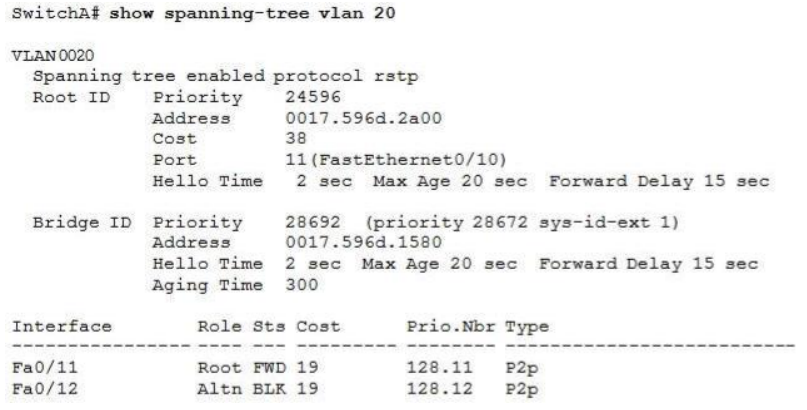- When you enable PortFast on a switch port, the port immediately transitions to which state?
- A. Blocking
- B. Forwarding*
- C. Learning
- D. Listening
Show (Hide) Explanation/ReferencePortFast causes a switch or trunk port to enter the spanning tree forwarding state immediately, bypassing the listening and learning states. - What can you change to select switch as root bridge?
- A. make lower priority*
- B. make higher priority
- C. make lower path cost
- D. make higher path cost
- Which type of port role does not participate in STP calculation?
- A. Listening
- B. Learning
- C. Forwarding
- D. Discarding*
- Which statement about spanning-tree root-bridge election is true?
- A. It is always performed automatically
- B. Each VLAN must have its own root bridge*
- C. Each VLAN must use the same root bridge
- D. Each root bridge must reside on the same root switch
Show (Hide) Explanation/ReferenceAnswer A is not correct as we can choose which switch to become root bridge by configuring bridge priority. The switch with lowest bridge priority (value) would become the root bridge.For answer B, this paragraph from Cisco confirms it is the correct answer:
“When you implement a root bridge in a switching network, you usually refer to the root bridge as the root switch. Each VLAN must have its own root bridge because each VLAN is a separate broadcast domain. The roots for the different VLANs can all reside in a single switch or in various switches.”
Reference: https://www.cisco.com/c/en/us/support/docs/lan-switching/spanning-tree-protocol/5234-5.html
The meaning of answer C is not clear but maybe it means “every VLAN must use the same root bridge” which is not correct as Sw1 can be the root bridge for VLANs 1, 3, 5 but Sw2 can be the root bridge for VLAN 2, 4, 6…
From the quote above we can say answer D is not correct.
- A question about BPDU. What would a PortFast BPDU guard port do when it is configured on a port? (Choose two)
- A. err-disabled when port receives BPDUs*
- B. supported only on nontrunking access ports*
- C. forward when port receives BPDUs
- D. supported on trunk ports
Show (Hide) Explanation/ReferencePortFast BPDU guard prevents loops by moving a nontrunking port into an errdisable state when a BPDU is received on that port. When you enable BPDU guard on the switch, spanning tree shuts down PortFast-configured interfaces that receive BPDUs instead of putting them into the spanning tree blocking state. In a valid configuration, PortFast-configured interfaces do not receive BPDUs. If a PortFast-configured interface receives a BPDU, an invalid configuration exists. BPDU guard provides a secure response to invalid configurations because the administrator must manually put the interface back in service. - What is one benefit of PVST+?
- A. PVST+reduces the CPU cycles for all the switches in the network
- B. PVST+automatically selects the root bridge location,to provide optimized bandwidth usage.
- C. PVST+allow the root switch location to be optimized per vlan.*
- D. PVST+supports Layer 3 load balancing without loops.
- For which two protocols can PortFast alleviate potential host startup issues? (Choose two)
- A. DHCP*
- B. DNS*
- C. OSPF
- D. RIP
- E. CDP
- Refer to the exhibit. Which statement is true?

- A. The Fa0/11 role confirms that SwitchA is the root bridge for VLAN 20.
- B. VLAN 20 is running the Per VLAN Spanning Tree Protocol.
- C. The MAC address of the root bridge is 0017.596d.1580.
- D. SwitchA is not the root bridge, because not all of the interface roles are designated.*
Show (Hide) Explanation/ReferenceOnly non-root bridge can have root port. Fa0/11 is the root port so we can confirm this switch is not the root bridge -> A is not correct.From the output we learn this switch is running Rapid STP, not PVST -> B is not correct.
0017.596d.1580 is the MAC address of this switch, not of the root bridge. The MAC address of the root bridge is 0017.596d.2a00 -> C is not correct.
All of the interface roles of the root bridge are designated. SwitchA has one Root port and 1 Alternative port so it is not the root bridge -> D is correct.
CCNA 200-125 Exam: STP Questions 3 With Answers
Subscribe
0 Comments
